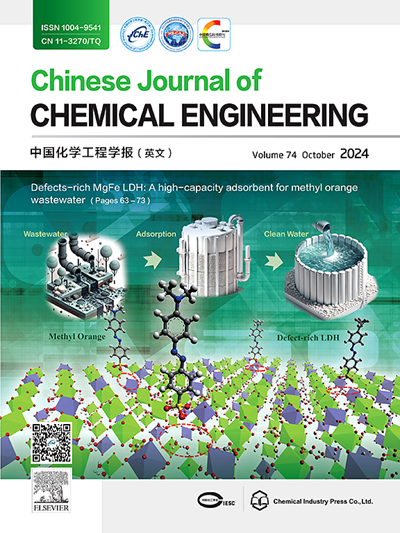钯纳米粒子与生物膜的耦合改善了铬和硝酸盐的共还原
IF 3.7
3区 工程技术
Q2 ENGINEERING, CHEMICAL
引用次数: 0
摘要
水中的铬(Cr)污染构成重大的健康风险,但先进的修复方法仍然有限。钯纳米颗粒(PdNPs)在氢转移膜上催化Cr(VI)还原显示出潜力,但需要进一步优化。本研究研究了微生物驱动和pd催化同时还原Cr(VI),重点研究了还原效率和最佳条件。对两种氢基膜反应器进行了比较:一种是将PdNPs与生物膜结合的pd -生物膜反应器,另一种是对照生物膜反应器。连续实验证明了pd -生物膜反应器的优越性能,与对照生物膜反应器的0.3 mg·L−1相比,pd -生物膜反应器可以立即降低Cr(VI),出水Cr(III)浓度低于0.040 mg·L−1。高通量测序发现,脱氯单胞菌是pd生物膜内的优势微生物,在金属离子还原中起关键作用。pd -生物膜反应器在不同条件下均保持较高的Cr(VI)还原通量。当进水Cr(VI)负荷达到10 mg·L−1时,对照生物膜反应器发生抑制,pd -生物膜反应器的Cr去除率达到99%。硝酸盐负荷和氢气压力的增加进一步提高了pd -生物膜反应器的性能,而不影响Cr(VI)的还原,因为Cr(VI)是优先的电子受体,而生物膜反应器需要氢气压力≥15 psig (1 psig = 6.895 kPa)才能达到类似的结果。pd -生物膜反应器中还原Cr(VI)的最佳pH范围为5.0 ~ 8.0,生物膜反应器中还原Cr(VI)的最佳pH范围为7.0,且碱性条件比酸性条件对Cr(VI)的抑制作用更强。pd -生物膜反应器能有效地将Cr(VI)浓度从1 ~ 10 mg·L−1降至0.1 mg·L−1以下,是一种处理Cr污染水体的有效技术。本文章由计算机程序翻译,如有差异,请以英文原文为准。

Coupling of palladium nanoparticles with biofilm improved co-reduction of chromium(VI) and nitrate
Chromium (Cr) contamination in water poses significant health risks, yet advanced remediation methods remain limited. Cr(VI) reduction catalyzed by palladium nanoparticles (PdNPs) on hydrogen-transfer membranes has shown potential but requires further optimization. This study investigated the simultaneous microbial-driven and Pd-catalyzed Cr(VI) reduction, focusing on reduction efficiency and optimal conditions. Two hydrogen-based membrane reactors were compared: a Pd-biofilm reactor incorporating PdNPs associated with a biofilm, and a control biofilm reactor. Continuous experiments demonstrated the superior performance of the Pd-biofilm reactor, achieving immediate Cr(VI) reduction and effluent Cr(III) concentrations below 0.040 mg·L−1, compared to 0.3 mg·L−1 in the control biofilm reactor. High-throughput sequencing identified Dechloromonas as the dominant microbial species within Pd-biofilm, which plays a critical role in metal ion reduction. The Pd-biofilm reactor maintained high Cr(VI) reduction flux across varying conditions. When the influent Cr(VI) loading reached up to 10 mg·L−1, where the control biofilm reactor experienced inhibition, the Pd-biofilm reactor achieved a Cr removal of 99%. Increased nitrate loading and hydrogen pressure further enhanced Pd-biofilm reactor performance without compromising Cr(VI) reduction since Cr(VI) is the preferential electron acceptor, whereas the biofilm reactor required hydrogen pressures ≥15 psig (1 psig = 6.895 kPa) for similar results. The optimal pH range for Cr(VI) reduction was 5.0–8.0 in the Pd-biofilm reactor and 7.0 in the biofilm reactor, with alkaline conditions being more inhibitory than acidic ones in both systems. The Pd-biofilm reactor effectively reduced Cr(VI) concentrations from 1 to 10 mg·L−1 to below the maximum contaminant level of 0.1 mg·L−1, thus appearing as an efficient technique to treat Cr-contaminated waters.
求助全文
通过发布文献求助,成功后即可免费获取论文全文。
去求助
来源期刊

Chinese Journal of Chemical Engineering
工程技术-工程:化工
CiteScore
6.60
自引率
5.30%
发文量
4309
审稿时长
31 days
期刊介绍:
The Chinese Journal of Chemical Engineering (Monthly, started in 1982) is the official journal of the Chemical Industry and Engineering Society of China and published by the Chemical Industry Press Co. Ltd. The aim of the journal is to develop the international exchange of scientific and technical information in the field of chemical engineering. It publishes original research papers that cover the major advancements and achievements in chemical engineering in China as well as some articles from overseas contributors.
The topics of journal include chemical engineering, chemical technology, biochemical engineering, energy and environmental engineering and other relevant fields. Papers are published on the basis of their relevance to theoretical research, practical application or potential uses in the industry as Research Papers, Communications, Reviews and Perspectives. Prominent domestic and overseas chemical experts and scholars have been invited to form an International Advisory Board and the Editorial Committee. It enjoys recognition among Chinese academia and industry as a reliable source of information of what is going on in chemical engineering research, both domestic and abroad.
 求助内容:
求助内容: 应助结果提醒方式:
应助结果提醒方式:


